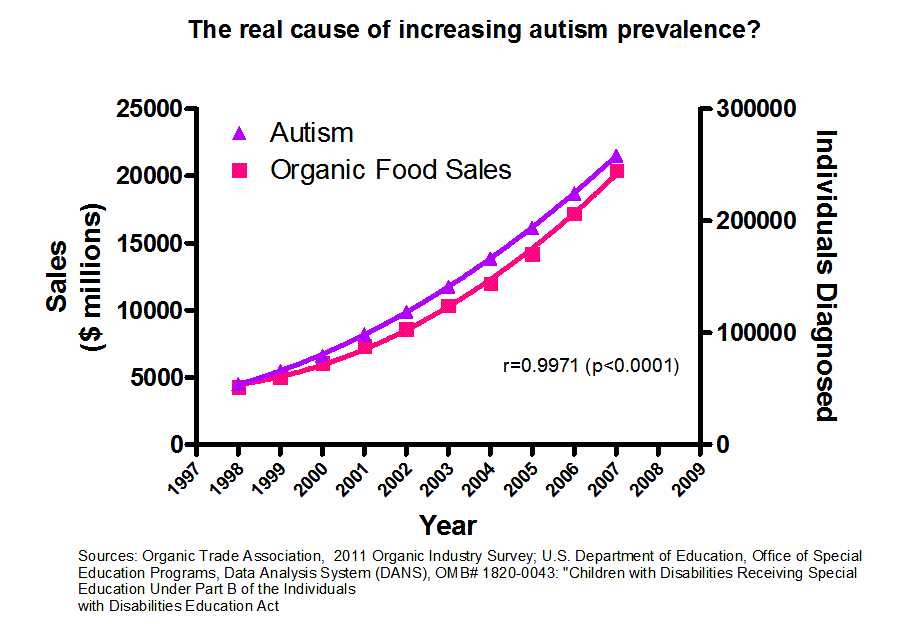*NOTE: I’m going to (perhaps foolishly) implore you to read the article before thrashing out against the graph*
When you have two (or more) data points that ‘line up just right’ (or, that correlate with one another) there are one of three ways of looking at the data. Either:
- A causes B
- B causes A
- Both A and B are consequences of a common cause
- Some combination of 1, 2, and 3 may be in place (which normally describes a self-reinforcing system, such as the predator-prey system, where one intrinsically affects the other and vice versa.
- A and B aren’t related and the correlation is a coincidence.
The logical fallacy of the ‘cum hoc ergo propter hoc’ argument goes something like this:
- A occurs in correlation with B
- Therefore, A causes B
The argument immediately leaps from a correlation to a conclusion rather prematurely. As stated above, there are at least five distinct ways the data can be explained. Because causation proves correlation, you can’t have two unrelated events that affect each other (in other words, they must be correlated). When two events are correlated, further study is needed to prove whether or not they are related. Edward Tufte criticizes the statement “correlation does not imply causation” by suggesting it’s inaccurate and incomplete. He suggests that causality and correlation can be best summarized by saying “Empirically observed covariation (correlation) is necessary but not a sufficient condition for causality. Correlation is not causation, but it sure is a hint.” Here are some further examples demonstrating this logical fallacy:
- As ice cream sales increase, the rate of drowning deaths increases. Therefore, ice cream causes drowning.
Obviously, the above example is ludicrous. It completely fails to account for the time/season and the temperature. In this case, the sale of ice cream and the rate of drowning is caused by a common cause – the summer months. When it’s hot outside, you’re more likely to eat ice cream and you’re more likely to swim. As the exposure to water-based activities increases, the number of people who don’t know how to swim or who simply get in trouble while swimming also increases which results in a higher drowning rate.
- Young children who sleep with the light on are much more likely to develop myopia later in life (myopia is near-sightedness). Therefore, sleeping with the light on causes myopia.
This example comes from a study done by the University of Pennsylvania’s Medical Center in 1999. Later, thanks to the peer review process, the Ohio State University disproved this claim and showed that myopia wasn’t caused by sleeping with the light on. Instead, OSU demonstrated a strong link between parental myopia and the development of child myopia, the study also noted that nearsighted parents where more likely to leave their child’s light on at night.
The list of both real-world scientific examples and make up logical exercises goes on, but that gives you the general idea. But, this raises an important question. If a correlation is established, how can you determine causation? Are they caused by the same thing? Does one cause the other? Are they completely unrelated? In order for one event to cause another, they must be related. In other words, there must be some real mechanism connecting the two events (assuming the correlation isn’t completely coincidental). Here, the cause and effect mechanism must comply with the known laws of nature – this (at least) gives us somewhere to start. Well-designed experimental studies, scientific models, statistical methods, and the scientific method in general is the scientist’s best friend. With careful documentation, intuitive thinking, and scrupulous study, together we are able to discover the secrets of the universe and to separate out these curveballs it likes to throws at us. So, have an organic apple in peace and go do some science.
Sources and further reading:
- A few amusing correlations that aren’t related to make a point
- When correlation is not causation
- Causation VS Correlation
- Correlation and Causality (video)
- Image source
Share This Article
